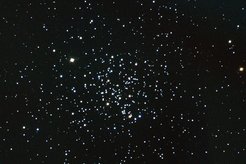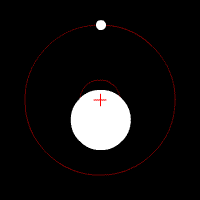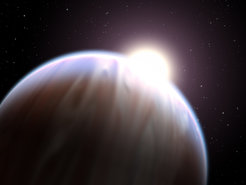Unexpected excess of giant planets in star cluster

The open star cluster M67 at a distance of about 2500 light-years.
The international team led by Roberto Saglia at the Max Planck Institute for Extraterrestrial Physics and Luca Pasquini at ESO has spent several years collecting high-precision measurements of 88 stars in Messier 67. This open star cluster is about the same age as the Sun and it is thought that the Solar System arose in a similarly dense environment.
The team used HARPS at the ESO La Silla 3.6m telescope as well as the High Resolution Spectrograph on the Hobby-Eberly Telescope in Texas, USA, to look for the signatures of giant planets on short-period orbits, hoping to see the tell-tale “wobble” of a star caused by the presence of a massive object in a close orbit, a kind of planet known as a hot Jupiters. This hot Jupiter signature has now been found for a total of three stars in the cluster alongside earlier evidence for several other planets.

Graphic illustration of the radial velocity or “wobble” method: as a small object (planet) orbits around a larger object (star), this produces changes in position and velocity of the larger body. The red cross denotes the common centre of gravity.
A hot Jupiter is a giant exoplanet with a mass of more than about a third of Jupiter’s mass. They are “hot” because they are orbiting close to their parent stars, as indicated by an orbital period (their “year”) that is less than ten days in duration. That is very different from the Jupiter we are familiar with in our own Solar System, which has a year lasting around 12 Earth-years and is much colder than the Earth.
“We want to use an open star cluster as laboratory to explore the properties of exoplanets and theories of planet formation”, explains Roberto Saglia. “Here we have not only many stars possibly hosting planets, but also a dense environment, in which they must have formed.” The open star cluster M67 in the constellation cancer is the nearest old open star cluster, and has already been well observed to study stellar evolution.
The study found that hot Jupiters are more common around stars in Messier 67 than is the case for stars outside of clusters. “This is really a striking result,” marvels Anna Brucalassi, who carried out the analysis. “The new results mean that there are hot Jupiters around some 5% of the Messier 67 stars studied — far more than in comparable studies of stars not in clusters, where the rate is more like 1%.”

Artists illustration of a Hot Jupiter with its host star peeking just over the horizon.
Astronomers think it highly unlikely that these exotic giants actually formed where we now find them, as conditions so close to the parent star would not initially have been suitable for the formation of Jupiter-like planets. Rather, it is thought that they formed further out, as Jupiter probably did, and then moved closer to the parent star. What were once distant, cold, giant planets are now a good deal hotter. The question then is: what caused them to migrate inwards towards the star?
There are a number of possible answers to that question, but the authors conclude that this is most likely the result of close encounters with neighbouring stars, or even with the planets in neighbouring solar systems, and that the immediate environment around a planetary system can have a significant impact on how it evolves. In a cluster like Messier 67, where stars are much closer together than on average, such encounters would be much more common, which would explain the larger numbers of hot Jupiters found there. In this scenario, the hot Jupiters should have eccentric orbits, due to the interaction with companion stars – and this is indeed the case for the three planets detected in M67.
Co-author and co-lead Luca Pasquini from ESO looks back on the remarkable recent history of studying planets in clusters: “No hot Jupiters at all had been detected in open clusters until a few years ago. In three years the paradigm has shifted from a total absence of such planets — to an excess!”
Note:
The international team of astronomers responsible for this discovery includes scientists from the Max Planck Institute for Extraterrestrial Physics, the University Observatory Munich, and the European Southern Observatory in Germany; the Astronomy Department of the Universidad de Chile; the Universidade Federal do Rio Grande do Norte in Brasil; the Observatoire de Paris in France; the Osservatorio Astronomico di Padova, the Osservatorio Astronomico di Catania, and the Osservatorio Astrofisico di Arcetri in Italy; as well as the Observatoire de Geneve in Switzerland.














